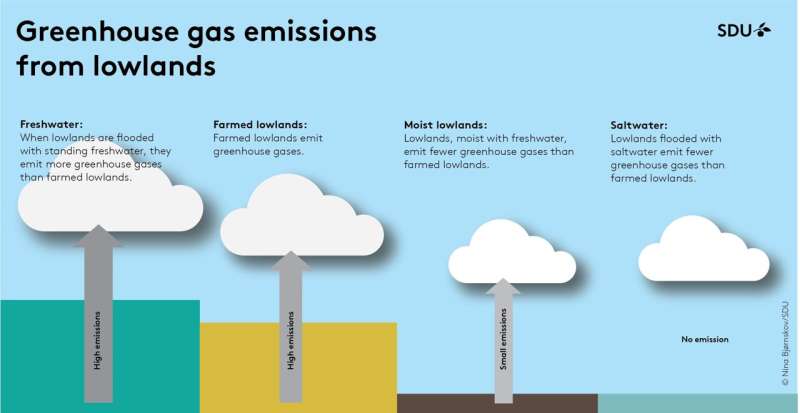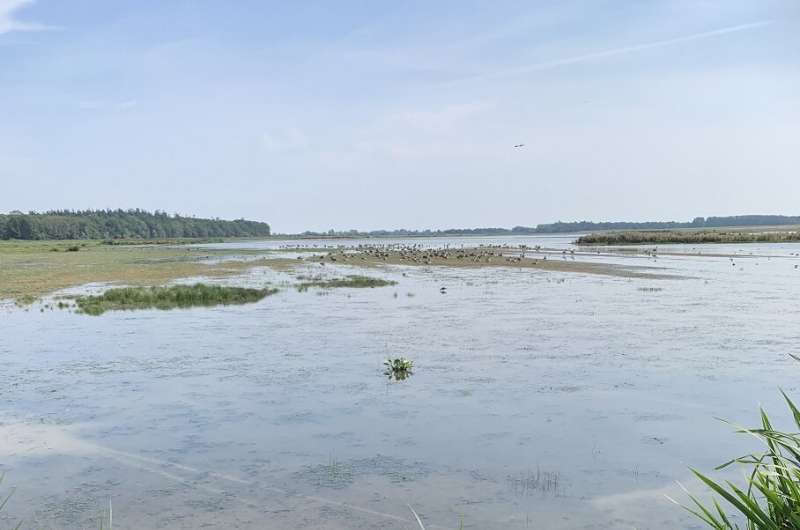This article has been reviewed according to Science X's editorial process and policies. Editors have highlighted the following attributes while ensuring the content's credibility:
fact-checked
trusted source
proofread
Study shows saltwater or freshwater is an important climate consideration when flooding low-lying areas

Many countries are considering or have already planned on converting low-lying farmland into wetlands in order to save CO2 emissions. The idea is that oxygen-depleted soil in wetlands emit less greenhouse gas than oxygenated cultivated land, thus benefiting the climate.
But such conversions could come with a surprisingly high price for the climate, biologists from University of Southern Denmark warn.
"There is a risk that new wetlands will end up emitting more greenhouse gases than they take up," says Erik Kristensen, professor of ecology at the University of Southern Denmark.
The problem is specifically tied to freshwater lakes with standing water. When the flooded area is just kept moist, like a bog, the methane emissions go down significantly.
Together with colleagues from the Department of Biology, Kristensen has followed a large land area named Gyldensteen Strand in Denmark for several years. In 2014, as part of a nature restoration project carried out by the Aage V. Jensen Nature Foundation, the area of cultivated low-lying land was flooded.
As the project is unique in Europe, researchers carried out a series of research projects aimed at learning more about what happens when former low-lying agricultural land is converted into wetlands. This knowledge can help legislators and authorities make the best possible and smartest decisions when agricultural land is taken out of use for wetlands.
"We have conducted this large-scale experiment for several years now, and it shows us that large amounts of methane are released into the atmosphere when land is flooded with freshwater, creating shallow lakes. That is why we say, if you want to convert low-lying coastal areas into wetlands, do it with saltwater if possible," says Kristensen.
The study, co-authored by Kristensen and biologist colleagues Susan Guldberg Petersen and Cintia Quintana from the University of Southern Denmark's Department of Biology, has been published in Estuaries and Coasts.
Gyldensteen Strand was flooded in two parts: one part with seawater after the removal of dikes, and another part with freshwater. It is the studies of the greenhouse gas emissions from these two different wetland areas that now lead researchers to warn against creating shallow freshwater lakes.

Bogs and wet meadows are better
"We see that when there is standing freshwater in a wetland, even if is only 10 centimeters of water, there is a significant methane emission. The same does not happen in an area flooded with saltwater," says Kristensen.
Therefore, he recommends flooding with seawater where possible. Alternatively, if there is only freshwater for flooding, standing water must be avoided; instead, the area should be laid out as a moist meadow with no standing water.
"The problem is standing water. Our studies show that when a freshwater area is only moist, such as a bog or a wet meadow without standing water, oxygen from the atmosphere will penetrate and help the bacteria in the moist surface consume all the methane that seeps up from deeper oxygen-free layers," explains Kristensen.
According to the study, significant amounts of methane are at play.
The researchers emphasize that their calculations are extrapolated from measurements and data from the freshwater area of Gyldensteen Strand, a lake called Engsø, which covers 144 hectares and has an average depth of 1 meter. The assumption for the calculation is that other areas behave somewhat similarly to Engsø.
"Some areas will emit less methane, while others will emit more, but overall, we believe we can extrapolate," says Kristensen.
The extrapolated calculations show that if 100,000 hectares are converted into freshwater wetlands with standing water, they will release methane equivalent to nearly 6 million tons of CO2 equivalents per year.
Of course, there is also a CO2 benefit from no longer cultivating these areas, which amounts to approximately 3 million tons of CO2 equivalents. This should be subtracted from the 6 million tons. Therefore, the net result is 3 million tons.
In other words, the 100,000 hectares would produce 3 million tons more CO2 equivalents than if they were still being farmed. This is equivalent to the emissions of approximately 750,000 cows. There are around 1.5 million cows in Denmark.
The other flooded area in Gyldensteen Strand is a coastal lagoon that was created after dikes were removed and seawater was allowed to flood the area.
"The numbers are much better in the coastal lagoon. No CO2 is emitted, which is an improvement compared to when it was agricultural land," says Kristensen.
The reason lies in the oxygen-depleted mud under the saltwater and freshwater, where different bacteria come into play.
Methane-producing bacteria thrive in freshwater but are inhibited in saltwater. They are also active when the soil is only moist, but then, atmospheric oxygen helps oxygen-consuming bacteria near the surface consume the methane. Therefore, only small amounts of methane are released from moist soils.
Future plans for low-lying land
However, the much lower oxygen content in standing water inhibits the methane-consuming bacteria, allowing large amounts of methane to be released, seeping or bubbling up through the water.
"When we are on field trips to Engsø and wade through the water, we can see bubbles forming where we walk. That's methane being released from the mud where we step," explains Kristensen.
He emphasizes that such methane bubbles should be considered when measuring methane emissions from freshwater wetlands.
"If you only measure the seepage, you get much lower values. But the bubbles should be taken into account to get an accurate picture. I believe that the knowledge we have gained from Gyldensteen Strand should be included in future water action plans so that we can design new wetlands in an intelligent way. Otherwise, there is a risk of creating wetlands that are not climate-friendly," says Kristensen.
More information: Susan Guldberg G. Petersen et al, Greenhouse Gas Emissions from Agricultural Land Before and After Permanent Flooding with Seawater or Freshwater, Estuaries and Coasts (2023). DOI: 10.1007/s12237-023-01218-6
Provided by University of Southern Denmark




















